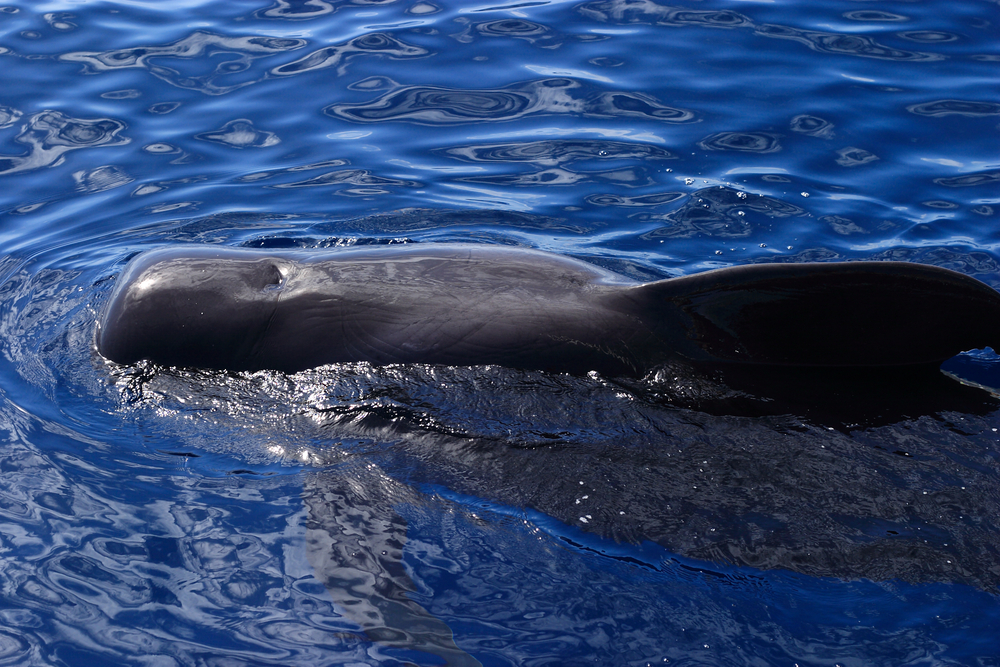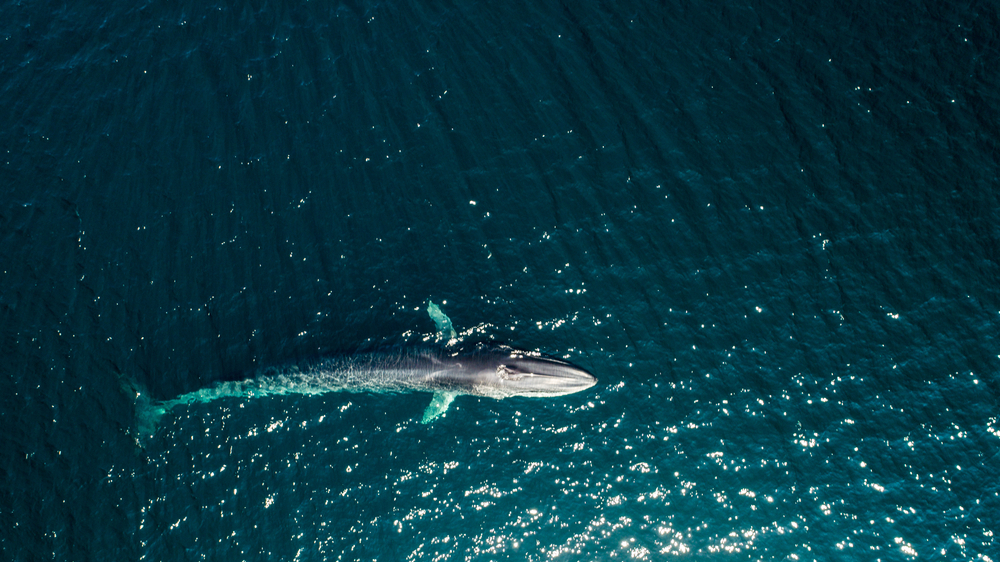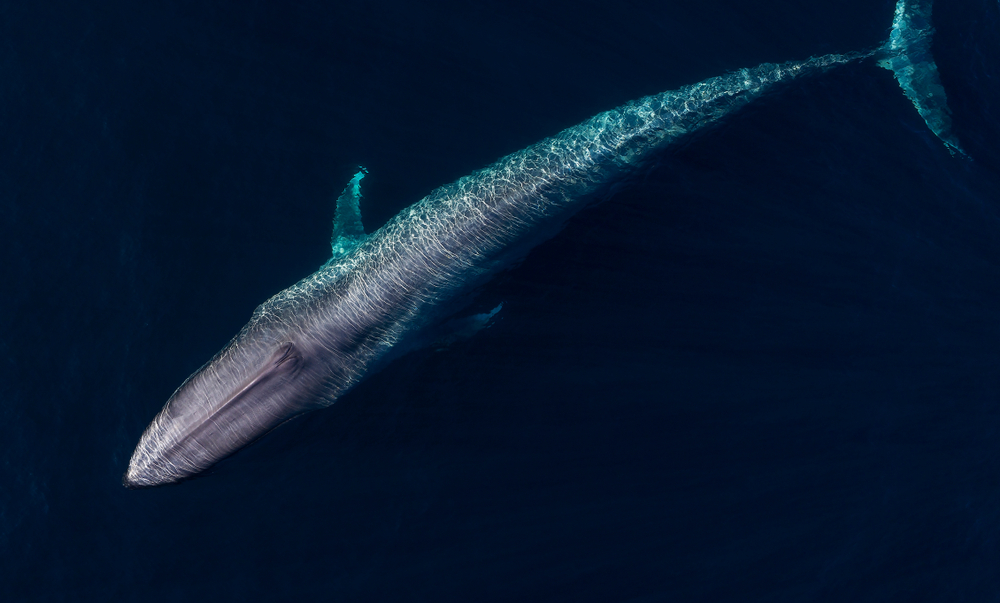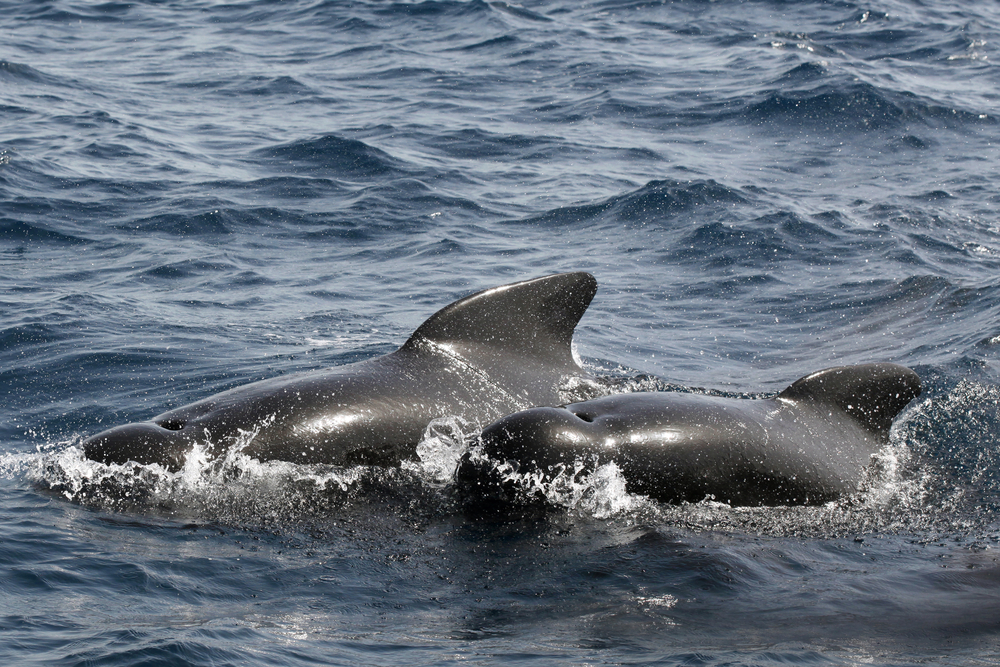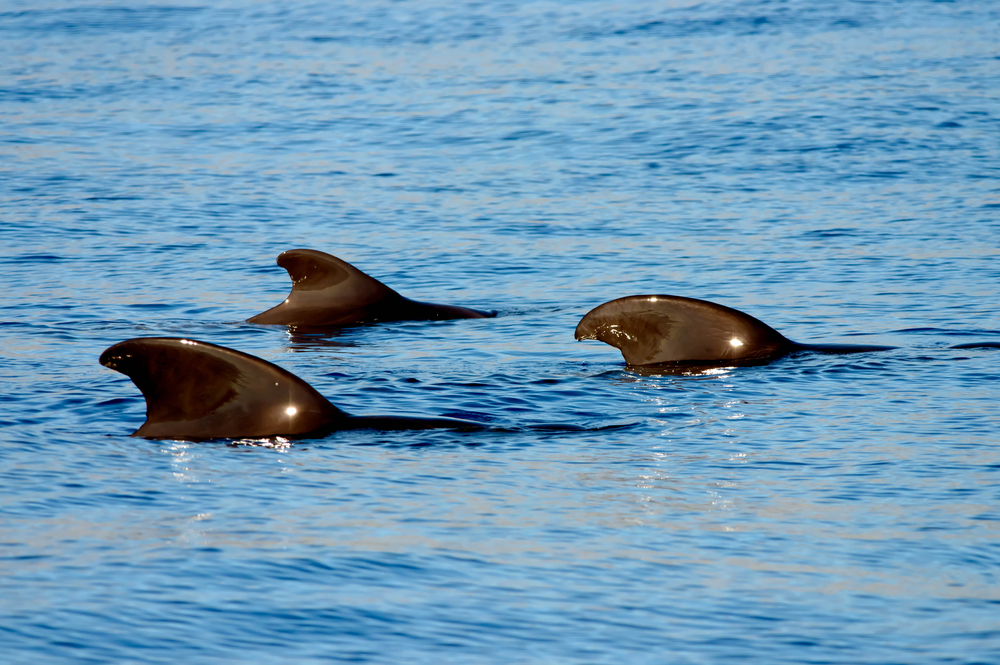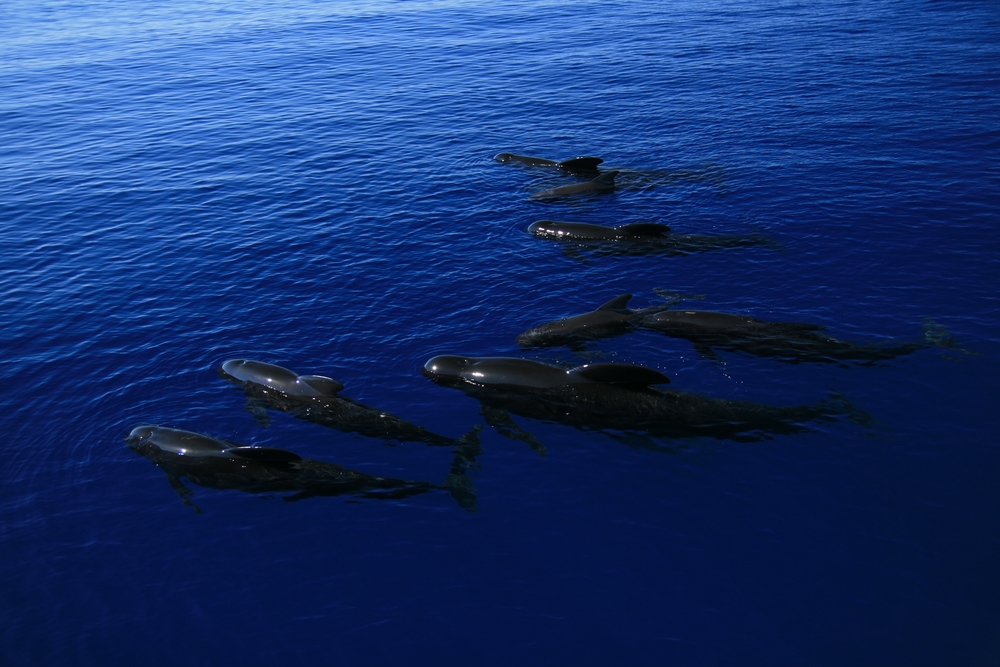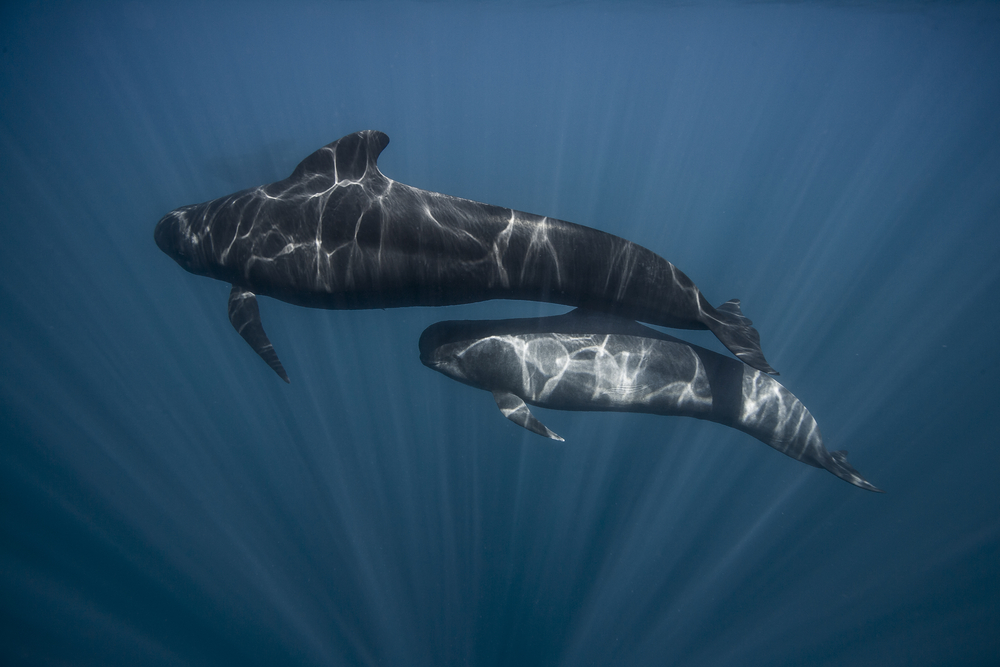The species of whale most like the pilot whale is the false killer whale. Both species share similar physical characteristics and behavioral traits, often found in social groups and displaying similar hunting strategies.
About
The Pilot Whale, scientifically known as Globicephala, belongs to the Animal Kingdom’s phylum Chordata and class Mammalia. It is a member of the dolphin family, Delphinidae, and is closely related to other cetaceans like killer whales and dolphins. Pilot whales inhabit oceans worldwide, primarily in temperate and subpolar regions.
These cetaceans exhibit a robust, elongated body with a distinctive bulbous forehead, or melon, and a long, tapered snout. They have dark, smooth skin and typically display a uniform coloration, ranging from black to dark gray. Pilot whales are highly social animals, often found in large, cohesive groups known as pods, which can consist of hundreds of individuals.
Pilot whales are renowned for their vocalizations, emitting a variety of clicks, whistles, and pulsed sounds used for communication and echolocation. They are skilled hunters, feeding primarily on squid and fish, including species like herring and mackerel. Pilot whales employ sophisticated group hunting strategies, coordinating their movements to capture prey efficiently.
Conservation Concerns
Pilot whales face various threats, including entanglement in fishing gear, habitat degradation, noise pollution, and chemical contaminants. Overfishing and depletion of prey species also impact their food availability, leading to nutritional stress and population declines.
While specific conservation measures targeting pilot whales are limited, broader initiatives aimed at reducing bycatch, mitigating human-induced ocean noise, and protecting marine habitats benefit these species indirectly. The IUCN Red List classifies pilot whales into two species: the long-finned pilot whale (Globicephala melas) and the short-finned pilot whale (Globicephala macrorhynchus). Both species are listed as “Data Deficient,” highlighting the need for further research and conservation efforts to better understand and protect these enigmatic cetaceans
Physical Characteristics
Pilot whales are part of the dolphin family (Delphinidae) and are known for their strong social bonds, forming pods that can number in the hundreds. There are two species of pilot whales: the long-finned pilot whale (Globicephala melas) and the short-finned pilot whale (Globicephala macrorhynchus). While there are differences between the two species, they share many physical characteristics. This description will focus on general features common to both species, with specific details where relevant.
Size
- Body Length: Adult pilot whales can vary significantly in size based on their species. Long-finned pilot whales usually measure between 19 to 25 feet (5.7 to 7.6 meters) in length, whereas short-finned pilot whales are slightly smaller, ranging from 12 to 24 feet (3.6 to 7.3 meters).
- Weight: They are substantial in weight, with long-finned pilot whales weighing up to 5,000 pounds (2,267 kilograms) and short-finned pilot whales up to 3,000 pounds (1,360 kilograms).
Physical Characteristics
- Body Shape: Pilot whales have a stocky body with an elongated, bulbous head. The body tapers more sharply toward the tail than in other dolphin species, giving them a distinctive profile.
- Skin Color and Texture: The skin is primarily black or dark gray, with a lighter gray or white patch on the belly. Some individuals may have a light gray or almost white anchor-shaped patch on their chest. The skin is smooth and sleek, an adaptation for efficient swimming.
- Head: The forehead is rounded and prominent, featuring a well-defined melon that is used for echolocation. The beak is short or almost non-existent, especially in comparison to other dolphin species.
- Fins: The dorsal fin is set forward on the back and is sickle-shaped, though the long-finned pilot whale has a more pronounced and larger dorsal fin than its short-finned counterpart. The pectoral fins are long and pointed, particularly in the long-finned pilot whale, from which it gets its name.
- Teeth: They have several pairs of large, sharp teeth in the lower jaw, which are used for catching squid and fish, their primary food sources.
- Tail: The tail flukes are wide and powerful, providing strong propulsion through the water.
Behavior and Adaptations
Pilot whales are deep divers, capable of plunging to depths of over 1,600 feet (500 meters) to hunt for squid, which constitutes a significant part of their diet. They are highly social animals, with strong family ties. Pods exhibit complex social structures and communication patterns, often staying together for life.
Both species of pilot whales are found in different oceans; the long-finned pilot whale prefers cooler waters and is typically found in the North Atlantic, while the short-finned pilot whale inhabits warmer waters, including those around Japan, the Pacific, and the Indian Ocean.
Pilot whales have been known to strand themselves in large groups, a behavior that is not fully understood but is thought to be related to their strong social cohesion. Their physical and social characteristics make pilot whales fascinating subjects of study in marine biology and conservation.
Reproduction
The reproductive cycle of Pilot Whales, covering both Long-Finned and Short-Finned species, is marked by distinct phases essential for the continuation of these deep-diving cetaceans:
- Mating and Courtship:
- Pilot whales do not have a fixed breeding season, allowing for mating activities to occur year-round. Courtship behaviors can be subtle and may include gentle touching, vocalizations, and close swimming.
- Gestation:
- The gestation period for pilot whales is approximately 12 to 16 months. This extended gestation ensures the calf is born well-developed, capable of swimming and diving shortly after birth.
- Birth and Maternal Care:
- Pilot whales typically give birth to a single calf; twins are extremely rare. At birth, calves are about 6 to 8.5 feet (1.8 to 2.6 meters) long and weigh approximately 135 to 220 pounds (60 to 100 kilograms).
- Newborns nurse for at least 2 years, though the nursing period can extend longer, depending on the calf’s development and the mother’s condition. Calves rely on their mothers for both nourishment and protection during this crucial early life stage.
- Infant Development:
- The bond between mother and calf is strong, with calves learning essential skills and social behaviors through observation and interaction within their pod.
- Sexual Maturity:
- Female pilot whales reach sexual maturity around 7 to 12 years of age, while males mature later, around 12 to 16 years. Males often do not begin breeding until they are larger and have established a higher social status within the pod.
Pilot whales have a relatively slow reproductive rate, with females giving birth once every 3 to 5 years. This slow rate, combined with their long lifespan and close-knit social structures, emphasizes the importance of each reproductive event in the population dynamics of these complex marine mammals.
Lifespan
Pilot Whales, including both Long-Finned (Globicephala melas) and Short-Finned (Globicephala macrorhynchus) species, exhibit significant longevity, marked by differences between life in the wild and under human care:
- Lifespan in the Wild:
- Pilot whales have relatively long lifespans, with females often living up to 60 years or more, while males typically live up to 45 years. There have been instances of females reaching ages beyond 60, showcasing their potential for longevity in natural conditions.
- Lifespan in Captivity:
- In captivity, the lifespan of pilot whales is generally shorter than in the wild, with many factors, including stress, limited space, and health issues, contributing to reduced longevity. Accurate data on captive lifespans are varied, but it is widely recognized that the complex needs of pilot whales are difficult to meet in captive environments.
- Biggest Threats:
- Bycatch: One of the significant threats to pilot whales is accidental capture in fishing gear, which can lead to injury or death.
- Whaling: In some parts of the world, pilot whales are still targeted for whaling operations, which can have a substantial impact on certain populations.
- Pollution: Chemical pollutants, plastics, and noise pollution in the oceans can adversely affect pilot whale health, impacting their reproduction and navigation abilities.
- Climate Change: Changes in ocean temperatures and prey availability may alter pilot whale migration patterns and access to food sources, posing a challenge to their survival.
Conservation efforts aimed at mitigating these threats are crucial for ensuring the continued survival of pilot whale populations. International regulations, protected marine areas, and research into their biology and ecology are essential components of these conservation strategies.
Eating Habits
Pilot Whales, including both the Long-Finned (Globicephala melas) and Short-Finned (Globicephala macrorhynchus) varieties, are known for their deep-diving capabilities, which play a crucial role in their feeding habits:
- Diet:
- The diet of pilot whales primarily consists of squid, which they hunt in deep waters. They also consume a variety of fish and, occasionally, octopus. Their preference for squid makes them one of the few cetacean species with such a diet focus.
- Feeding Techniques:
- Pilot whales are adept at deep diving to locate their prey, often reaching depths where squid are known to reside. These dives can last several minutes and reach depths of over 1,600 feet (about 500 meters), demonstrating their exceptional diving abilities.
- They employ echolocation to navigate and locate prey in the dark depths of the ocean. This biological sonar involves emitting sound waves that bounce off objects, returning echoes that provide the whale with information about the size, shape, speed, and location of its prey.
- Group hunting tactics may also be observed, with pilot whales working together to herd or concentrate their prey, making it easier to capture.
- Adaptations for Feeding:
- Their large, bulbous heads house complex structures necessary for echolocation, a critical adaptation for locating prey in deep, dark waters.
- Strong social bonds within pilot whale pods aid in coordinated hunting efforts, showcasing their collaborative nature and intelligence.
Pilot whales’ specialized diet and deep-diving hunting strategies highlight their unique niche within marine ecosystems. Their ability to locate and capture squid in the ocean’s depths underscores the adaptability and skill of these marine mammals in their natural habitats.
Uniqueness
Pilot Whales, encompassing both the Long-Finned (Globicephala melas) and Short-Finned (Globicephala macrorhynchus) species, possess several unique characteristics that set them apart from other marine mammals:
- Deep Diving Abilities: Pilot whales are among the deepest diving mammals, capable of reaching depths of over 1,600 feet (500 meters) in search of squid and other prey. These extraordinary diving capabilities are facilitated by their physiological adaptations to withstand high pressure and low oxygen environments.
- Social Structure: They exhibit highly social behavior, living in matrilineal pods that can number in the dozens. These pods are characterized by strong, long-lasting bonds, with individuals often remaining with their maternal group for life. The social cohesion within pods is crucial for their hunting strategies and protection against predators.
- Vocal Communication: Pilot whales use a complex array of vocalizations for communication and echolocation. Their sounds play a vital role in navigating the dark depths of the ocean, locating prey, and maintaining social bonds within the pod.
- Diet Focused on Squid: While many cetaceans have varied diets, pilot whales specialize in consuming squid, including deep-water species. This dietary preference underscores their role in the marine food web and their adaptation to deep-sea hunting.
- Size and Appearance: With their robust bodies, large bulbous heads, and distinctive dorsal fins, pilot whales are easily recognizable. The males of both species are notably larger than females, with pronounced foreheads that become more prominent with age.
- Mass Stranding Events: Pilot whales are known for their susceptibility to mass strandings, a phenomenon not fully understood. These events highlight the strong social bonds within pilot whale pods, as individuals often follow one another into danger.
These unique attributes not only make pilot whales a subject of scientific interest but also emphasize the importance of conservation efforts to protect these remarkable creatures and their habitats from human-induced threats and environmental changes.
FAQ’s
1. What species of whales is most like the pilot whale?
2. How fast does the pilot whale swim?
Pilot whales typically swim at speeds of around 3 to 5 miles per hour (5 to 8 kilometers per hour). They are not known for exceptional speed but are highly adapted for endurance swimming over long distances.
3. How deep and long do pilot whales dive?
Pilot whales are known to dive to depths of up to 2,000 feet (600 meters) or more, but their typical dive depth ranges from 300 to 900 feet (100 to 300 meters). They can stay submerged for up to 10 to 15 minutes, although dives of around 5 to 10 minutes are more common.
Related Family Species
Sources
- Britannica, Pilot Whale, https://www.britannica.com/animal/pilot-whale, February 2024.
- Burnie, David & Wilson, Don, Animal, Smithsonian Institute, Washington DC.
- Clutton-Brock, Juliet and Wilson, Don, Mammals, Smithsonian Handbooks, New York, NY.
- Hickman et al, Integrated Principle of Zoology, McGraw Hill, Boston.



































































